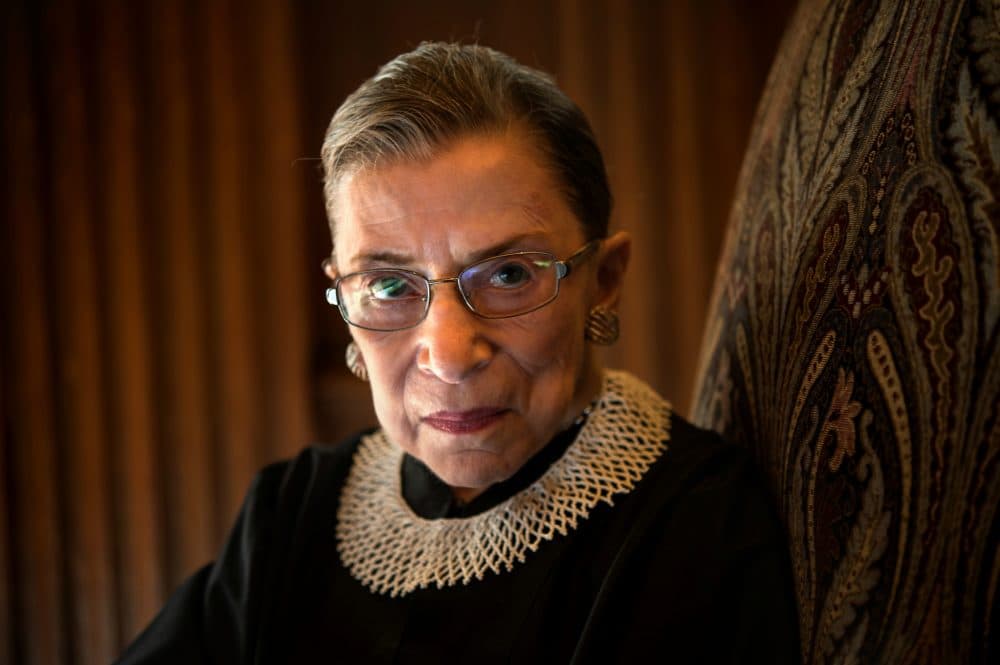Advertisement
Remembering Ruth Bader Ginsburg
Resume
Remembering Justice Ruth Bader Ginsburg. Her work in the 1970s proved that the Constitution prohibits gender discrimination and that equality between the sexes ought to be an affirmative American right. We talk with women in law today about how Ginsburg changed the nation.
Guests
Nancy Gertner, senior lecturer on law at Harvard Law School. Former U.S. federal judge. (@ngertner)
Kathleen Peratis, partner at Outten & Golden. Director of the Women’s Rights Project at the ACLU from 1975 to 1979. She worked with Justice Ginsburg on most of the gender discrimination cases the ACLU brought before the Supreme Court in the 1970s.
Barbara McQuade, law professor at the University of Michigan. U.S attorney for the Eastern District of Michigan from 2015-2017. Assistant U.S. attorney in Detroit for 12 years, serving as deputy chief of the National Security Unit. (@BarbMcQuade)
Laura Brill, law clerk for Justice Ginsburg from 1996-1997. Founder and director of The Civics Center, a nonprofit that focuses on high school voter registration and civic engagement. Partner at Kendall Brill & Kelly. (@LWBrill)
Interview Highlights
On RBG's legacy
Nancy Gertner: “She was a model of someone who was going to take fancy lawyer skills and put them at the service of social change. And she was going to put them at the service of social change in an effective way, in a remarkably fine-tuned way. And so it wasn't just going into court and fulminating about social change. It was literally carefully, like a craftsman, trying to figure out how to effect social change, using the tools that the Constitution gave us. It's so easy now after the fact to say, hey, you know, we all know what she was arguing 20 years ago. But we did not know.
"… Just the fact that you could generalize about women and stereotype women wasn't enough to justify treating all women alike. The fact that women had physical differences from men wasn't enough to justify discrimination that had nothing to do with those physical differences. And the fact that sometimes laws were intended to protect women wasn't enough to justify their continuation. Where in fact, as she described it, ‘They put women not on a pedestal, but in a cage.’ So the things that we take for granted, she deftly and carefully explained and busted the myths.”
On Justice Ginsburg’s 'incremental approach' to law
Barbara McQuade: “I think most of us who have experienced discrimination feel an urgency and we want to grab the power brokers by the lapels and shake them and say this needs to change now. But I think Justice Ginsburg recognized that the way to affect change requires winning hearts and minds. And sometimes that does require an incremental approach. You know, one of the strategies that she used … is she was very selective in choosing her plaintiffs in her cases. She chose men to make the point that discriminatory laws could have adverse impacts on both genders because she thought it might be more persuasive to the male justices. And so these laws intended to benefit women could be just as harmful because they were based on stereotypes and not on actual facts.
“And so it did require an incremental approach. But she ultimately got the court to recognize that the 14th Amendment's equal protection clause applied to gender discrimination. And by doing that, she was able to not only eradicate these laws that were harming men, but to have a positive impact on women and to create equal opportunity. So she played the long game even, you know, in her later years. Most often she found herself in the minority filing dissenting opinions. But by filing those dissenting opinions, she can shape the law. It was her dissenting opinion in the Ledbetter case regarding equal pay that led to the passage of the Lilly Ledbetter Equal Pay Act. And so I think she took a historical perspective: I might not make a change overnight, but if I can take this one step at a time, we can achieve significant change over time.”
On Justice Ginsburg’s mother
Barbara McQuade: “One of the things that's so interesting is that Ruth Bader Ginsburg, I think her views were shaped very much by her own experiences. She had a mother who was intellectually curious and bright, who never had a chance to go to college and died just before Ruth Bader Ginsburg graduated from high school. She herself, despite being a top graduate from Columbia Law School, was rejected from New York law firms. And even Justice Felix Frankfurter said he would not hire her because he did not want to hire a woman clerk.
"And so those denials had to shape who she was and had to motivate her to try to change these things. And in fact, when she was introduced by Bill Clinton in the Rose Garden as his nominee to the Supreme Court, she said that she was paying tribute to her mother in dreaming of a world where women may have opportunities to fulfill all of their dreams based on their talents, and where girls in this world are cherished as much as boys.”
On Ginsburg’s approach to language
Laura Brill: “She cared very much about words and language. And one of the ways that came through was in really trying to fairly present the arguments of the other side. Let's say if she was ruling against a party or if there was a dissent, you know, not misrepresenting anything. And also being careful not to overstate things and to state things with great accuracy. I'll say there are a couple of words, specific words that stand out that she liked to use. She would use 'pathmarking' for a very important new opinion instead of groundbreaking. She liked the word 'waypaver' for somebody who had blazed a new trail. And I think that was part of her using language to draw connections to people and to shine light instead of creating barriers."
On RBG’s relationship with Justice Sandra Day O'Connor
Laura Brill: “She did have a very strong bond with Justice O'Connor. The year I was clerking, they were misidentified and mistaken for one another by the oral advocates on multiple occasions. And to the extent that they got T-shirts made up that said, 'I'm Sandra not Ruth.' And 'I'm Ruth, not Sandra.' And, you know, they had a very strong bond. And I think despite that personal sense of loneliness, I do think she took a lot of pride in seeing the ways in which women had advanced in the profession and the way her law clerks were working around the country as judges, and law professors and involved in public life.”
From The Reading List
NPR: "Justice Ruth Bader Ginsburg, Champion Of Gender Equality, Dies At 87" — "Justice Ruth Bader Ginsburg, the demure firebrand who in her 80s became a legal, cultural and feminist icon, died Friday. The Supreme Court announced her death, saying the cause was complications from metastatic cancer of the pancreas."
New York Times: "For Women, the Death of Ruth Bader Ginsburg Brings a Particular Grief" — "In Waco, Texas, Lily Coffman, 15, donned her handmade 'R.B.G.' coronavirus mask and 'dissent collar' earrings on Saturday night and joined a small crowd of mostly mothers and daughters in a candlelight vigil at the county courthouse."
Associated Press: "Ginsburg’s impact on women spanned age groups, backgrounds" — "Sure, there were the RBG bobbleheads, the Halloween getups, the lace collars, the workout videos."
New York Magazine: "Ginsburg’s Example Shows Us How to Save Our Democracy" — "Bader Ginsburg’s dying wish was that she 'not be replaced until a new president is installed.' Despite well-founded cynicism in our government leaders, there is reason to be optimistic that her wish will come true, if we are willing to work for it — as she always was."
Washington Post: "Ruth Bader Ginsburg was all I wanted to be" — "I was in my late 20s, attending a conference for women lawyers in the 1970s. I sat in the front row of a large auditorium for the keynote address."
This program aired on September 21, 2020.

